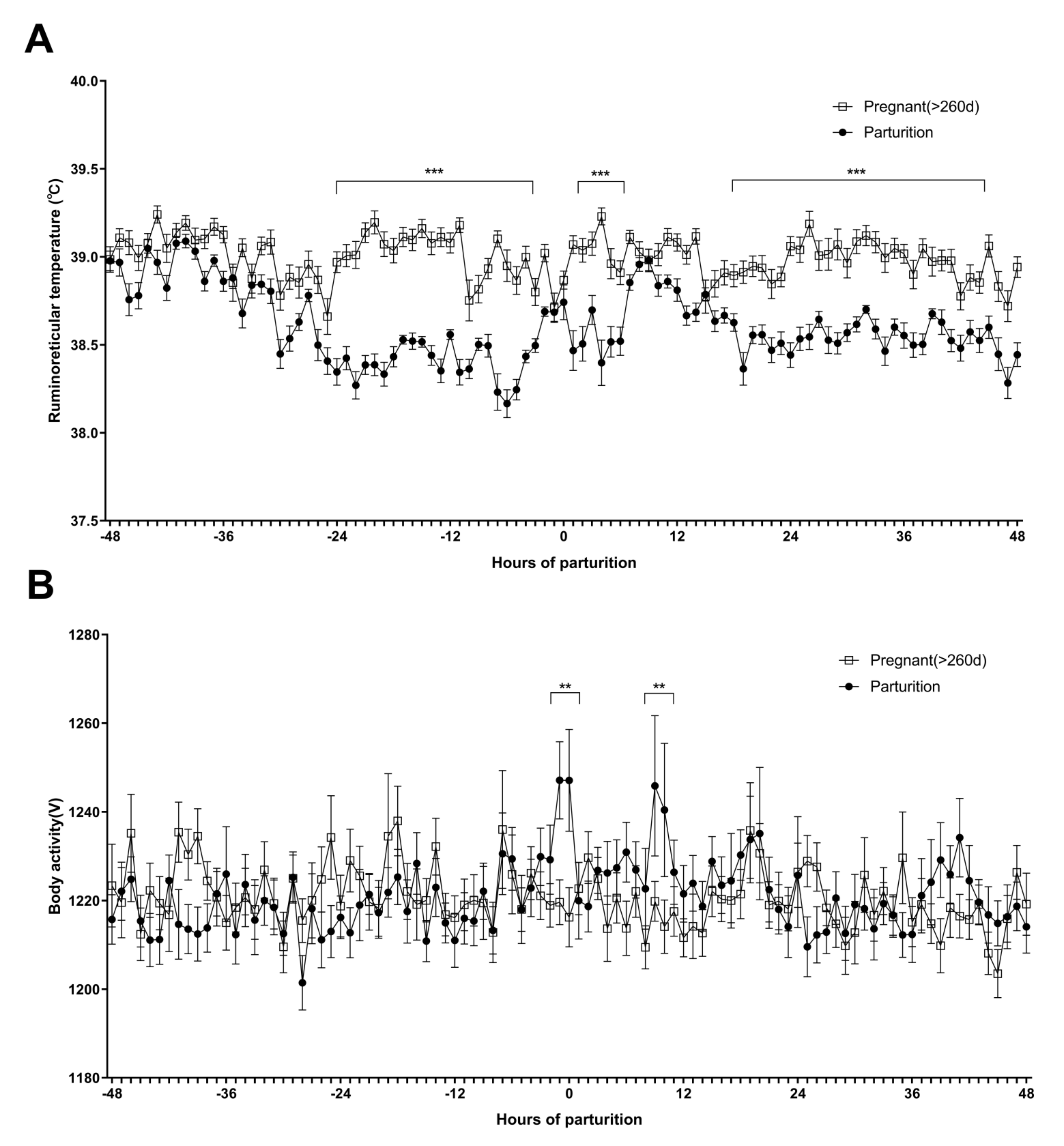Change of Ruminoreticular Temperature and Body Activity before and after Parturition in Hanwoo (Bos taurus coreanae) Cows
Abstract
:1. Introduction
2. Case Presentation
2.1. Animals and Management
2.2. Measurement of Ruminoreticular Temperature and Body Activity
2.3. Pregnancy Test
2.4. Statistical Analysis
2.5. Experimental Results
3. Discussion
4. Conclusions
Author Contributions
Funding
Institutional Review Board Statement
Informed Consent Statement
Data Availability Statement
Acknowledgments
Conflicts of Interest
References
- Gasteiner, J.; Horn, M.; Steinwidder, A. Continuous measurement of reticuloruminal pH values in dairy cows during the transition period from barn to pasture feeding using an indwelling wireless data transmitting unit. J. Anim. Physiol. Anim. Nutr. 2015, 99, 273–280. [Google Scholar] [CrossRef] [PubMed]
- Ammer, S.; Lambertz, C.; von Soosten, D.; Zimmer, K.; Meyer, U.; Danicke, S.; Gauly, M. Impact of diet composition and temperature-humidity index on water and dry matter intake of high-yielding dairy cows. J. Anim. Physiol. Anim. Nutr. 2018, 102, 103–113. [Google Scholar] [CrossRef] [PubMed]
- Gil, Z.; Kural, J.; Szarek, J.; Wierzchos, E. Increase in milk and body temperature of cows as a sign of embryo entry into the uterus. Theriogenology 2001, 56, 685–697. [Google Scholar] [CrossRef]
- Scanavez, A.L.A.; Fragomeni, B.; Rocha, L.; Voelz, B.E.; Hulbert, L.E.; Mendonca, L.G.D. Association between 4-day vaginal temperature assessment during the dry period and performance in the subsequent lactation of dairy cows during the warm season. J. Anim. Sci. 2017, 95, 5208–5217. [Google Scholar] [CrossRef] [PubMed] [Green Version]
- Suthar, V.S.; Burfeind, O.; Bonk, S.; Dhami, A.J.; Heuwieser, W. Endogenous and exogenous progesterone influence body temperature in dairy cows. J. Dairy Sci. 2012, 95, 2381–2389. [Google Scholar] [CrossRef] [PubMed]
- Kim, D.; Ha, J.; Yi, J.; Kim, B.; Kwon, W.; Ye, B.; Kim, S.; Lee, Y. Differences in ruminal temperature between pregnant and non-pregnant Korean cattle. J. Anim. Reprod. Biotechnol. 2021, 36, 45–50. [Google Scholar] [CrossRef]
- Cooper-Prado, M.J.; Long, N.M.; Wright, E.C.; Goad, C.L.; Wettemann, R.P. Relationship of ruminal temperature with parturition and estrus of beef cows. J. Anim. Sci. 2011, 89, 1020–1027. [Google Scholar] [CrossRef] [PubMed] [Green Version]
- Titler, M.; Maquivar, M.G.; Bas, S.; Rajala-Schultz, P.J.; Gordon, E.; McCullough, K.; Federico, P.; Schuenemann, G.M. Prediction of parturition in Holstein dairy cattle using electronic data loggers. J. Dairy Sci. 2015, 98, 5304–5312. [Google Scholar] [CrossRef] [PubMed]
- Kim, H.; Oh, S.; Ahn, S.; Choi, B. Real-time Temperature Monitoring to Enhance Estrus Detection in Cattle Utilizing Ingestible Bio-Sensors: Method & Case Studies. J. KIIT 2017, 15, 65–75. [Google Scholar]
- Choi, W.; Ro, Y.; Hong, L.; Ahn, S.; Kim, H.; Choi, C.; Kim, H.; Kim, D. Evaluation of ruminal motility using an indwelling 3-axis accelerometer in the reticulum in cattle. J. Vet. Med. Sci. 2020, 82, 1750–1756. [Google Scholar] [CrossRef] [PubMed]
- Burfeind, O.; Suthar, V.S.; Voigtsberger, R.; Bonk, S.; Heuwieser, W. Validity of prepartum changes in vaginal and rectal temperature to predict calving in dairy cows. J. Dairy Sci. 2011, 94, 5053–5061. [Google Scholar] [CrossRef] [PubMed] [Green Version]

| Cow ID | Day of Parturition (Year-Month-Day) | Time of Parturition (Hour:Minute) | Sex | Birth Weight (kg) |
|---|---|---|---|---|
| #13-81 | 2019-02-05 | 17:10 | Female | 20 |
| #16-18 | 2019-02-22 | 18:10 | Female | 27 |
| #16-25 | 2019-04-01 | 22:00 | Male | 30 |
| #16-26 | 2019-03-01 | 14:30 | Female | 30 |
| #16-4 | 2019-03-06 | 18:30 | Male | 27 |
| #17-28 | 2019-02-27 | 15:20 | Male | 24 |
| #17-29 | 2019-02-24 | 14:29 | Female | 22 |
| #17-3 | 2019-03-07 | 01:10 | Female | 24 |
| #17-36 | 2019-02-26 | 14:30 | Male | 28 |
| #17-44 | 2019-03-03 | 07:00 | Male | 27 |
| #19-02 | 2019-02-08 | 23:00 | Male | 30 |
| #19-03 | 2019-02-09 | 18:45 | Male | 28 |
| #19-06 | 2019-02-14 | 20:30 | Female | 38 |
| #19-08 | 2019-02-15 | 10:30 | Male | 28 |
| #19-09 | 2019-02-15 | 17:50 | Female | 31 |
| #19-13 | 2019-02-17 | 22:00 | Male | 19 |
| #19-19 | 2019-02-20 | 12:20 | Male | 32 |
| #19-21 | 2019-02-21 | 15:30 | Male | 30 |
| #19-26 | 2019-02-25 | 02:30 | Male | 28 |
| #19-30 | 2019-02-27 | 22:40 | Male | 34 |
| #391 | 2019-03-01 | 11:40 | Female | 24 |
| #411 | 2019-03-08 | 04:20 | Female | 34 |
| #431 | 2019-03-17 | 12:30 | Male | 39 |
| #432 | 2019-03-21 | 01:10 | Female | 31 |
Publisher’s Note: MDPI stays neutral with regard to jurisdictional claims in published maps and institutional affiliations. |
© 2021 by the authors. Licensee MDPI, Basel, Switzerland. This article is an open access article distributed under the terms and conditions of the Creative Commons Attribution (CC BY) license (https://creativecommons.org/licenses/by/4.0/).
Share and Cite
Kim, D.; Ha, J.; Kwon, W.-S.; Moon, J.; Gim, G.-M.; Yi, J. Change of Ruminoreticular Temperature and Body Activity before and after Parturition in Hanwoo (Bos taurus coreanae) Cows. Sensors 2021, 21, 7892. https://doi.org/10.3390/s21237892
Kim D, Ha J, Kwon W-S, Moon J, Gim G-M, Yi J. Change of Ruminoreticular Temperature and Body Activity before and after Parturition in Hanwoo (Bos taurus coreanae) Cows. Sensors. 2021; 21(23):7892. https://doi.org/10.3390/s21237892
Chicago/Turabian StyleKim, Daehyun, Jaejung Ha, Woo-Sung Kwon, Joonho Moon, Gyeong-Min Gim, and Junkoo Yi. 2021. "Change of Ruminoreticular Temperature and Body Activity before and after Parturition in Hanwoo (Bos taurus coreanae) Cows" Sensors 21, no. 23: 7892. https://doi.org/10.3390/s21237892
APA StyleKim, D., Ha, J., Kwon, W.-S., Moon, J., Gim, G.-M., & Yi, J. (2021). Change of Ruminoreticular Temperature and Body Activity before and after Parturition in Hanwoo (Bos taurus coreanae) Cows. Sensors, 21(23), 7892. https://doi.org/10.3390/s21237892









